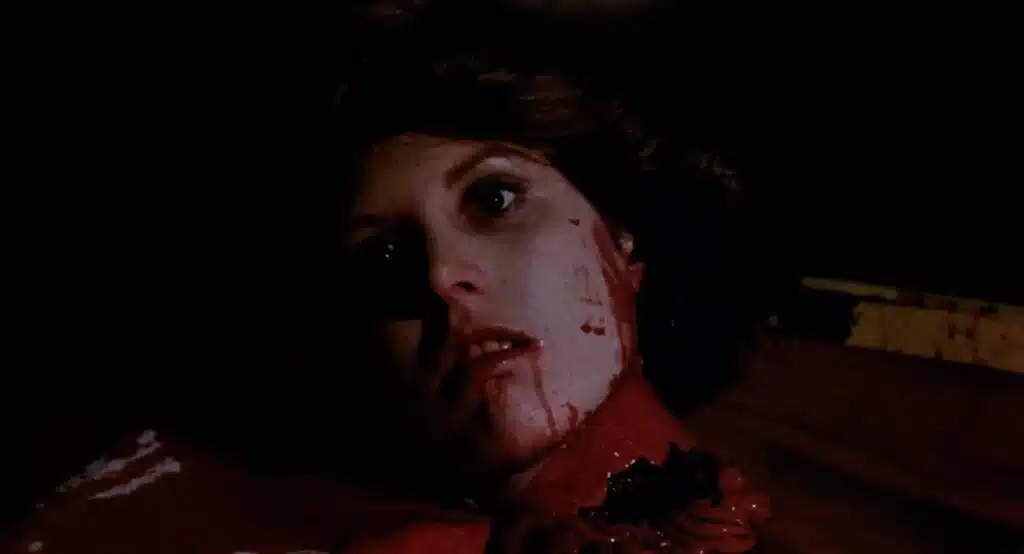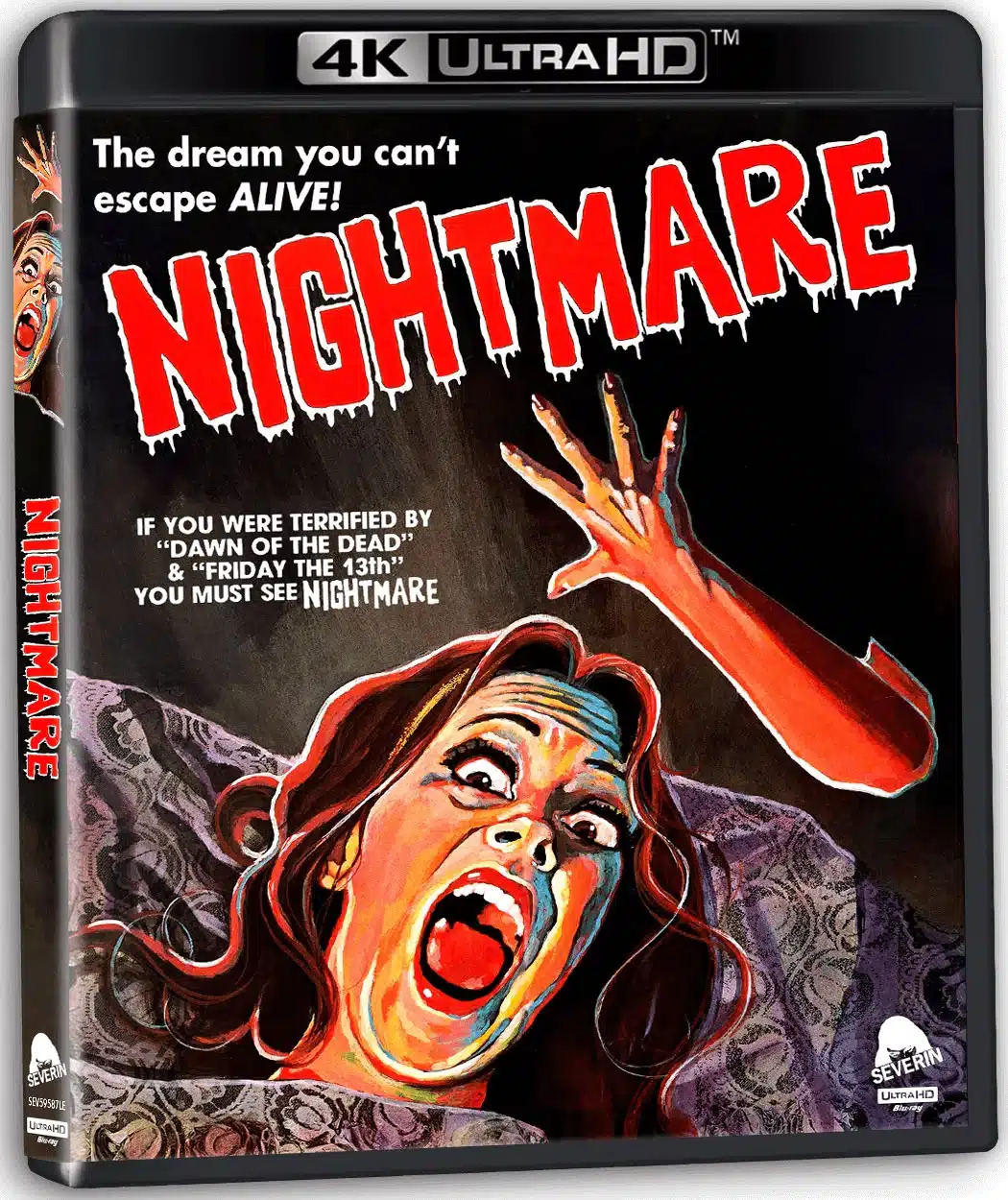
You’ve gotta love a film that straight away states its intent (and understand a film which needs to sell its merits pretty damn quickly) and Nightmare (1981) does both of these things. We’re off with a dream of a dismembered body, a shrieking nightmare, a man in a straightjacket – and the immediate need to sedate him, so powerful are his dreams. Then come the opening credits – a gloriously early 80s run of red and black, and a claim that Tom Savini did the SFX, which he categorically denies. No messing about, then. The film has established itself as a gory, feverish, bloody unpleasant film and it does not disappoint at any point during its runtime.
Director Romano Scavolini gets ahead of the trend by about thirty-five years by adding intertitles here: the film is carved up into days, and you may be surprised by how much happens on each particular day. Hence, Night One: a babysitter’s trite dismissal of kids complaining that ‘someone is looking through the window’ segues into more dreams and flashbacks, but establishes that this is, in fact, an early American slasher (albeit with an Italian director). Our guy in the straightjacket is George Tatum (Baird Stafford), and his mental plight is of great interest to a crack team of psychiatrists and other medical professionals, who, for reasons best known to themselves, see in him the prospect of a total recovery from his conditions (and it’s quite a list – worthy of a Twitter bio). Of course George isn’t successfully cured – this would be a short, and likely very dull film if he were – but, right as rain, his care team turn him out onto the streets of New York anyway, jacked up with experimental medication and operating on the promise of turning up to outpatients once in a while. George does the obvious thing and instead heads to 42nd Street to sequester himself in a peep show or two. But the flashbacks are breaking through already: ladies and gentlemen, this is only the first day of the timeline proper, and George’s mind is already fracturing.
On Day Two – Day Two! George decides to head off on a road trip. His rather woolly psychiatrist finally notices he hasn’t arrived to his session, but doesn’t really think much beyond that for now: in the meantime, George is heading out of state which, if bad news for the experimental treatment programme, is by far worse news for a number of innocent women he encounters on his way. On his way to where, though? He seems to be particularly fixated on one address and one family in particular: he keeps calling, then hanging up, but he seems to be closing in on the household, which consists of one single mother and children. Will the treatment team deign to catch up with George before he catches up with this family, with which he has certain…ties? (It’s not looking all that likely, is it?)
Nightmare, sometimes known by the rather more embellished Nightmares in a Damaged Brain, is part of horror history. The film’s role in the whole video nasties furore is well known – but is it a film which deserves to be seen today? Actually, it is. For starters, it’s a well made, shot and lit film with a superb score, already confident enough in its use of horror and plot tropes to throw a few red herrings in there from time to time. Scavolini knows what he’s doing, and it shows. It’s also an undoubtedly OTT, gory and profoundly mean-spirited vision; unlike many of its peers, swept onto the video nasties lists for still mystifying reasons, Nightmare is, at least, a genuinely nasty video. It may be over forty years old at the time of writing, but it still looks and feels ambitious, without ever compromising on its visual style and themes. Ungoverned by most of the concerns which frequently hem in today’s filmmakers, it can be gratuitous and salacious (nudity often, suddenly breaks out in Nightmare) without feeling it needs to resolve things, or dish out comeuppances in the right proportions to the ‘right’ people. None of this makes Nightmare a nice film. But it does lend it a strangely refreshing, unconcerned quality.
It doesn’t seem to have set out to change the world, then – but Nightmare does have a few features which distinguish it further, especially at a distance of forty years from now. Its cynical spin on psychiatric medicine is interesting; clearly pride comes before a fall in the world of the film, as it’s the self-congratulatory, laissez-faire attitude of George Tatum’s doctors which sets the ball rolling here. It’s not a social commentary as such, but the film does offer an interesting take on what itself is a rather voyeuristic and potentially harmful branch of medicine, as seen in the world of the film at least. I mean, if we’re looking for moral lessons here – not advised, but possible – you could even say that not leaving your children with a disinterested babysitter could be one of them. We could take it further, and say that having children at all is a risky business, as the film plays with the furthest extremes of the nature/nurture debate.
But perhaps the film’s quality as a time capsule is where its secondary charms really lie. Now, 42nd Street is, for most people reading this review or about to pick up the Severin print of this film, someone else’s nostalgia. But it feels like our nostalgia anyway, even if for most of us always refracted through oddball exploitation and horror cinema from the past. Something else which now feels like it belongs to the past is the role of the landline telephone: the terror of it ringing, the potentially unknown weirdo on the other end, its relationship to your home, where you should feel most secure. A withheld number on a smartphone is just not scary in the same way; today, horror is more interested in phones when they don’t work, rather than when they do – but I digress. The film retains its grainy, retro look, by the way, but this print looks extraordinarily good, clean enough to be fully legible, with great colour balance and blacks which really pop off the screen. Nightmare in this version feels both near and far, looking and sounding as good as you can imagine it ever could. All in all, this is a fascinating, if grotty trip down memory lane balanced against a still watchable. engaging, unapologetic horror film, and as such it comes highly recommended. You could do far, far worse than head over to Severin and pick up a copy, which comes with a clutch of excellent special features, or click here if you’re a UK reader.
